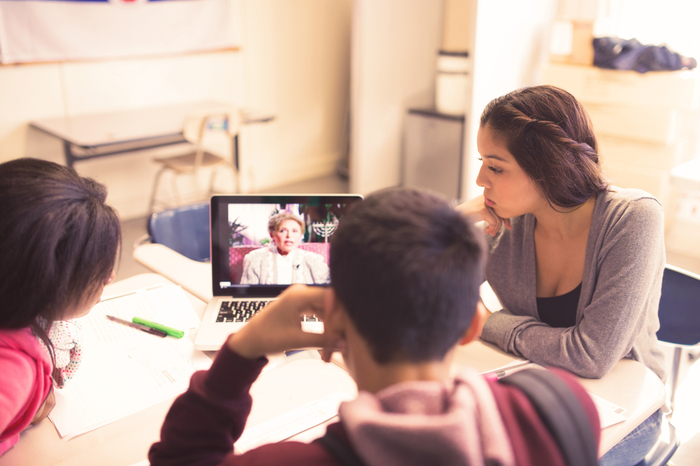
RESCUERS
RESISTANCE

What is courage? Do we all have the ability to act heroically? When we decide to behave courageously, is it because we’ve already determined that the risk, danger, or potentially hazardous outcome is worth it? How about those whose actions are courageous, but motivation may be selfish? What responsibility do we, as educators, bear in humanizing acts of courage for our students?
Children hear endless stories of heroism and courage; where muscle-bound superheroes typify valor by saving the world, or ‘good guys’ take down ‘bad guys’ in an epic battle royale, standing up for those whose rights have been abused or trampled. This binary structure of good and evil evolves to encompass those who fight in wars against totalitarianism, champions of human rights and social change showing that progress, action, and tolerance can win a decisive victory against darkness. But does our veneration of courageous acts limit how a young person sees themselves in acting with empathy and action to change their world? Does this view attach itself to a narrative of heroism that may make these actions seem inaccessible to an everyday person?
As educators, it’s important to show courage not as a single definitive act, but as iterative, sometimes minute, actions that help others to live with dignity. Individual acts of courage and humanity serve as beacons of hope during times of upheaval and cataclysm, and in its most extreme, stand as testament to one’s ability to confront and resist extreme evil. During the Holocaust, there were individuals and groups who tried to help Jewish people at great personal risk; with punishments severe and in some cases under penalty of death. For instance, in Echoes & Reflections, we discuss the actions of the Danish citizens when hearing of the planned implementation of the Nazi’s Final Solution, standing as an example of how both individuals and communities can act within their own agency on behalf of others. Danes during the Second World War founded the Elsinore Sewing Club, and using speedboats, fishing boats, and other means of transportation ferried Jewish citizens to safety across the sea to neutral Sweden.
The idea that courage is singular, situational and momentary is fallible. The act of riding into battle or stopping a fight, or standing up for your values, all of this is predicated on the notion that to act courageously means to act with the conviction of a single moment. But courage is complicated. It’s sustained. It’s messy. We tend to venerate those who hid Jews during the Holocaust without knowing or understanding the parameters or motivation behind their actions. The Girl in the Green Sweater, for instance tells the story of a family’s survival in the sewers of Lvov during the Holocaust. Leopold Socha, a municipal sewer worker who smuggled the family food in exchange for a fee, helped sustain 21 people daily. If someone behaves courageously, but does so for money, protection, or capital gain, does it negate the good their actions have prompted? Is courage a morally neutral value?
To many during in the Holocaust, courage was not a single definitive moment in time, but a collection of moments – for those who hid Jewish families, courage was a daily test, and for those who hid, courage was fighting back through the simple act of remaining alive. As Miep Gies, who risked her life to hide the Frank family, once stated, “People sometimes call me a hero. I don’t like it, because people should never think that you have to be a very special person to help those who need you.”
As we discuss the concept of courage and its complexities with students when teaching the Holocaust, bringing in stories of a small kindness and large, momentous movements can help students contextualize how their everyday behaviors impact the lives of those around them, and how they can navigate the complex moral ecosystem of social life with empathy and goodness that may never be written about in text books, but may make a lasting imprint on the lives of those around them.

RESCUERS

This blog is reposted from the USC Shoah Foundation’s Impact in Profile
Jason Hensely’s project to interview Kindertransport survivors who were taken in by Christadelphians during World War II began in 2015 with an Echoes and Reflections online professional development program.
In 2014, Hensley, a principal at Christadelphian Heritage School in Simi Valley, California who specializes in teaching about Christianity and the Holocaust, had attended the Belfer National Conference for Educators at the United States Holocaust Memorial Museum in Washington, D.C., to learn more about teaching the Holocaust.
Following the conference, one of his instructors, Echoes and Reflections trainer and classroom teacher Jennifer Goss, invited him to participate in a new Echoes and Reflections online professional development course. The course would instruct educators on teaching the Holocaust, utilizing testimony in the classroom, and integrating other primary and secondary sources. At the end of the course, each participant was required to create an original lesson to utilize with students in their classrooms.
“It hit me that in teaching my Holocaust Studies course, we’ve been talking about Christadelpians and the ways in which Christadelphians helped Jewish children, and I thought ‘Ah, this is what we need to look at,’” Hensley said. “It really revolved around this idea of individual stories.”
Christadelphians are a small Christian sect. Hensley estimates that about 250 Jewish children were sheltered by Christadelphians in Britain during World War II.
Hensely searched in IWitness for any mentions of Christadelphians and was surprised to find one testimony, Suse Rosenstock.
“No one has any clue who Christadelphians are, they’re such a small little group. I was blown away to find one video,” Hensley said. “She talked about all her experiences in detail and that was hugely inspiring.”
With his students, Hensley set out to find out as much as he could about Christadelphians and the Kindertransport. They pored through old Christadelphian magazines looking for stories written about the Holocaust during the war and even watched testimony in the Visual History Archive (VHA) while on a field trip to the Los Angeles Museum of the Holocaust.
“The kids started going through the different [museum] exhibits and I went to a computer and searched “Christadelphians,” and found seven videos,” Hensley said. “I started running through the museum telling them all. I think the kids thought I was a little crazy.”
In addition to providing background information about Jewish children’s experiences with Christadelphians, the testimonies in the Visual History Archive also led Hensley directly to survivors themselves and their families. He was able to get in touch with the families of two survivors he watched in the VHA.
So far, Hensely has filmed two interviews with survivors who recount their experiences living with Christadelphian families during the war. He has also written a book, Part of the Family: Christadelphians, the Kindertransport and Rescue from the Holocaust, based on his research.
The project would not have happened if it weren’t for Echoes and Reflections and the professional development course he was invited to participate in, Hensley said. Through Echoes and Reflections, Hensley realized the importance of discovering and sharing the stories of individuals in the Holocaust. And through testimony, Hensley was able to do his own original research and tell stories that in many cases have never been told before.
“I think if you allow it to, Echoes and Reflections will change your life,” Hensley said. “It will give you a whole different perspective on understanding the Holocaust. It will change the way you think about things and, in doing so, change the way you act. It really brings you face to face with survivors and you get to hear what they experienced and you get to be moved by it.”
Jason Hensley, M.A.Ed, is the principal of Christadelphian Heritage School, a small private school in California where he teaches religious studies and a senior-level course on Christianity and the Holocaust.




This site contains links to other sites. Echoes & Reflections is not responsible for the privacy practices or the content of such Web sites. This privacy statement applies solely to information collected by echoesandreflections.org.
We do not use this tool to collect or store your personal information, and it cannot be used to identify who you are. You can use the Google Analytics Opt-Out Browser Add-on to disable tracking by Google Analytics.
We currently do not use technology that responds to do-not-track signals from your browser.
Users may opt-out of receiving future mailings; see the choice/opt-out section below.
We use an outside shipping company to ship orders. These companies are contractually prohibited from retaining, sharing, storing or using personally identifiable information for any secondary purposes.
We may partner with third parties to provide specific services. When a user signs up for these services, we will share names, or other contact information that is necessary for the third party to provide these services.
These parties are contractually prohibited from using personally identifiable information except for the purpose of providing these services.
1. You can unsubscribe or change your e-mail preferences online by following the link at the bottom of any e-mail you receive from Echoes & Reflections via HubSpot.
2. You can notify us by email at info@echoesandreflections.org of your desire to be removed from our e-mail list or contributor mailing list.





 English
English